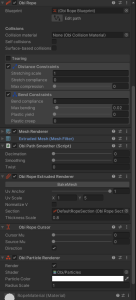Hello,
I am developing a project using the system in your Hook project as a reference. I can lengthen and shorten the rope, but the rope has problems interacting with colliders, as far as I understand the particle count is low. How can I increase this? If my method is wrong, please tell me.
When I wrap it around an obstacle, the rope vibrates.
Example of the project I am trying to make: https://play.google.com/store/apps/detai...lley&pli=1
Point A is fixed, point B is moveable.
Thank you



I am developing a project using the system in your Hook project as a reference. I can lengthen and shorten the rope, but the rope has problems interacting with colliders, as far as I understand the particle count is low. How can I increase this? If my method is wrong, please tell me.
When I wrap it around an obstacle, the rope vibrates.
Example of the project I am trying to make: https://play.google.com/store/apps/detai...lley&pli=1
Point A is fixed, point B is moveable.
Thank you

Code:
using System.Collections;
using System.Collections.Generic;
using UnityEngine;
using Obi;
using System;
public class RopeCreate : MonoBehaviour
{
[Header("Obi")]
[SerializeField] Transform ropeEnd;
public ObiSolver solver;
public ObiCollider2D character;
public float hookExtendRetractSpeed = 2;
public Material material;
public ObiRopeSection section;
private ObiRope rope;
private ObiRopeBlueprint blueprint;
private ObiRopeExtrudedRenderer ropeRenderer;
private ObiRopeCursor cursor;
private RaycastHit hookAttachment;
public Rigidbody2D characterRb;
void Awake()
{
// Create both the rope and the solver:
rope = gameObject.AddComponent<ObiRope>();
ropeRenderer = gameObject.AddComponent<ObiRopeExtrudedRenderer>();
ropeRenderer.section = section;
ropeRenderer.uvScale = new Vector2(1, 5);
ropeRenderer.normalizeV = false;
ropeRenderer.uvAnchor = 1;
rope.GetComponent<MeshRenderer>().material = material;
// Setup a blueprint for the rope:
blueprint = ScriptableObject.CreateInstance<ObiRopeBlueprint>();
blueprint.resolution = 0.5f;
// Tweak rope parameters:
rope.maxBending = 0.02f;
// Add a cursor to be able to change rope length:
cursor = rope.gameObject.AddComponent<ObiRopeCursor>();
cursor.cursorMu = 0;
cursor.direction = true;
}
private void Start()
{
if (!rope.isLoaded)
LaunchHook();
Debug.Log(GetRopeLength());
}
private void OnDestroy()
{
DestroyImmediate(blueprint);
}
/**
* Raycast against the scene to see if we can attach the hook to something.
*/
private void LaunchHook()
{
StartCoroutine(AttachHook());
}
private IEnumerator AttachHook()
{
yield return null;
Vector3 startLocal = transform.position;
Vector3 endLocal = ropeEnd.position;
Vector3 direction = (endLocal - startLocal).normalized;
blueprint.path.Clear();
blueprint.path.AddControlPoint(startLocal, -direction, direction, Vector3.up, 0.1f, 0.1f, 1, 1, Color.white, "Hook start");
blueprint.path.AddControlPoint(endLocal, -direction, direction, Vector3.up, 0.1f, 0.1f, 1, 1, Color.white, "Hook end");
blueprint.path.FlushEvents();
yield return blueprint.Generate();
rope.ropeBlueprint = blueprint;
rope.GetComponent<MeshRenderer>().enabled = true;
var pinConstraints = rope.GetConstraintsByType(Oni.ConstraintType.Pin) as ObiConstraints<ObiPinConstraintsBatch>;
pinConstraints.Clear();
var batch = new ObiPinConstraintsBatch();
batch.AddConstraint(rope.solverIndices[0], character, transform.localPosition, Quaternion.identity, 0, 0, float.PositiveInfinity);
batch.AddConstraint(rope.solverIndices[blueprint.activeParticleCount - 1],
ropeEnd.GetComponent<ObiColliderBase>(),
//ropeEnd.position,
//ropeEnd.InverseTransformPoint(ropeStart.position),
Vector3.zero,
Quaternion.identity, 0, 0, float.PositiveInfinity);
batch.activeConstraintCount = 2;
pinConstraints.AddBatch(batch);
rope.SetConstraintsDirty(Oni.ConstraintType.Pin);
}
public void RopeIncrease()
{
cursor.ChangeLength(rope.restLength + hookExtendRetractSpeed * Time.deltaTime);
}
public void RopeDecrease()
{
cursor.ChangeLength(rope.restLength - hookExtendRetractSpeed * Time.deltaTime );
}
public float GetStrain()
{
float strain = rope.restLength / rope.CalculateLength();
return strain;
}
public float GetRopeLength()
{
return rope.CalculateLength();
}
}Code:
public class CapsuleMove : MonoBehaviour
{
[SerializeField]RopeCreate ropeCreate;
[Header("Move")]
const float speed = 500f;
private Vector3 mOffset;
private float mZCoord;
private bool active;
private Rigidbody2D rb;
float startRotation;
[SerializeField] public bool isRopeLengthMax = false;
public Vector2 startPos;
private Vector2 previousPosition;
private void Start()
{
rb = GetComponent<Rigidbody2D>();
}
private void OnMouseDown()
{
mZCoord = Camera.main.WorldToScreenPoint(transform.position).z;
mOffset = transform.position - GetMouseAsWorldPoint();
active = true;
rb.velocity = Vector2.zero;
rb.gravityScale = 0f;
rb.constraints &= ~RigidbodyConstraints2D.FreezePositionX;
rb.constraints &= ~RigidbodyConstraints2D.FreezePositionY;
}
private void OnMouseUp()
{
MouseDownEnded();
}
private void MouseDownEnded()
{
active = false;
rb.gravityScale = 1f;
rb.velocity = Vector2.zero;
// rb.freezeRotation = true;
rb.constraints = RigidbodyConstraints2D.FreezePositionX | RigidbodyConstraints2D.FreezePositionY | RigidbodyConstraints2D.FreezeRotation;
}
private Vector3 GetMouseAsWorldPoint()
{
Vector3 mousePoint = Input.mousePosition;
mousePoint.z = mZCoord;
return Camera.main.ScreenToWorldPoint(mousePoint);
}
private void FixedUpdate()
{
if (isRopeLengthMax)
{
MouseDownEnded();
return;
}
if (active)
{
Vector2 desiredPosition = (Vector2)(GetMouseAsWorldPoint() + mOffset);
Vector2 direction = desiredPosition - rb.position;
rb.velocity = direction.magnitude > 0.1f ? direction * Time.fixedDeltaTime * speed : Vector2.zero;
float distanceMoved = Vector2.Distance(rb.position, previousPosition);
if (distanceMoved < 0.05f)
{
return;
}
if (ropeCreate.GetStrain() > .9)
{
ropeCreate.RopeDecrease();
}
else
{
ropeCreate.RopeIncrease();
// Debug.Log("Lenght" + ropeCreate.GetRopeLength());
}
previousPosition = rb.position;
}
}
}




